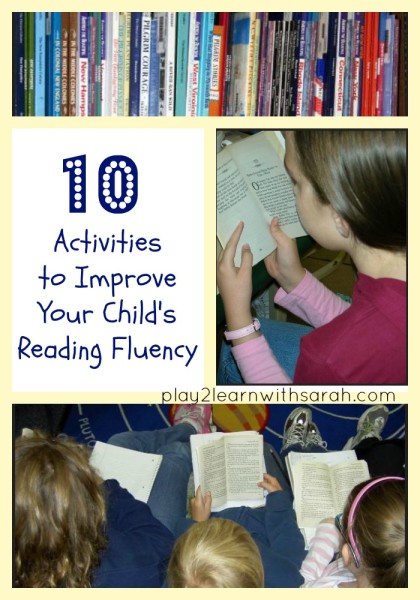There are many, many, many things that go into becoming a successful reader, but one of the biggest is fluency.
The National Reading Panel defined fluency as “the ability to read text accurately and smoothly. When fluent readers read aloud, their expression, intonation, and pacing sound natural – much like speaking.”
Becoming a fluent reader really relies heavily on no longer needing to sound words out, but knowing them on sight. There are many reading activities that can help and here I’ll give you my top ten. Choose a couple each week to do with your child and you will be amazed at how their reading ability improves.
Activities to Improve Reading Fluency
1. Buddy Reading – Have your child read an “easier book” to a younger sibling, family member or neighbor. Have them practice a few times before reading to them.
2. Choral Reading – Choose a passage or short book that is on your child’s level or a little easier. Read it aloud to your child the first time while they follow along. Then read it again, but this time have them join in.
3. Book Walk – Always start each new book with a book walk. Look through the book, comment on the pictures, make predictions. This gives your child a hint about what the book is about and enables them to make better “guesses” if they meet an unfamiliar word.
4. Take Turns – You read the first page of the book. Then your child reads the second page and you the third and so on. It gives you a chance to model fluent reading and gives them a chance to enjoy the story too.
5. Echo Reading – Instead of taking turns reading the pages, your child will read the same page right after you read it. All the words are fresh in their mind and they can model their reading on yours.
6. Reader’s Theater – I LOVE Reader’s Theater. It’s like putting on a play, but you get to use the paper. Here’s an example of a 2 character reader’s theater script. You can also just have them practice poems and read them aloud.
7. Timed Reading – Time your child reading a short passage or book. Write down the time and then have them do it two more times. See if they improve. Graph those times and then come back to the graph the next week when you do timed reading again. The graph is really key to visually showing them how they are improving.
8. Recorded Books – Borrow books on “tape” and the book from the library. Play the book while they follow along. You can also create books yourself by downloading Audacity and creating your own for the books you have.
9. Taped Reading – Have your child make the recordings of the books themselves and listen to themselves reading. It might help them realize how they sound.
10. Chunking – Take a 5-7 sentence passage (or type one up from a book) and put slashes where you would pause while reading (prepositional phrases, punctuation. etc). Read the passage modeling how you pause at certain points in sentences and then have them read it. (The little red wagon/ran down the hill./The little boy/ran after it.)
I hope these activities help give you some strategies to use with your child. Reading fluency has become a big part of the yearly reading tests that they give children in school. Even if your child can read at a higher level, they may not be scored that high if their fluency is low, so it really is worth working on these strategies weekly.






